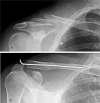Midshaft clavicle fractures treatment: threaded Kirschner wire versus conservative approach
- PMID: 28825169
- PMCID: PMC5653602
- DOI: 10.1007/s11751-017-0293-7
Midshaft clavicle fractures treatment: threaded Kirschner wire versus conservative approach
Abstract
Clavicle fractures are common, accounting for 2.6 to 10% of all fractures. Treatment of these fractures is usually non-surgical. Recent evidence, however, reveals that the final result of non-surgically midshaft clavicular fractures, particularly those with quite large displacements or shortening, is not like that which was previously thought. This study evaluated retrospectively all patients presented with a clavicle fracture at Emergency Department of our Institution, between January 2006 and December 2011. Fractures were classified according to Allman's radiographic classification system, modified by Nordqvist and Petersson. Patients were distinguished into two groups: one that underwent conservative treatment with a "figure-of-8" orthosis and one that underwent surgery with reduction in fracture and fixation with intramedullary threaded Kirschner wire. Pin removal was performed after 4 weeks of rest in Gilchrist bandage, after clinical and radiographic evaluation demonstrating the bone healing. The QuickDASH score and the Constant Murley Shoulder Score were used to evaluate the clinical outcomes. The radiographic outcome was evaluated at 1 and 6 months of follow-up. Database review provided a final cohort of 58 patients, with similar demographic features. There was no significant difference in qDASH and CS between the two groups. The results of qDASH and CS evaluated in function of the radiographic outcome show a statistically significant correlation between the worst qDASH and CS results and the grade of malunion in both groups. In particular, we have found unsatisfactory results when final shortening of the clavicle was 20 mm or more. On radiographic evaluation, surgical treatment demonstrated a greater efficacy in reducing initial shortening of the fractured bone; this is in opposition to conservative treatment that results very often in malunion, shortening, anatomic alterations and loss of functionality. The use of intramedullary threaded Kirschner wire for fixation of midshaft clavicle fractures is a safe procedure and is recommended in case of shortening greater than 2 cm in high-function-demand patients.
Keywords: Clavicle fracture; Clavicle pinning; Conservative treatment; Midshaft; Mini invasive.
Conflict of interest statement
Conflict of interest
The authors declare that they have no conflict of interest.
Ethical approval
All procedures performed in studies involving human participants were in accordance with the ethical standards of the institutional and/or national research committee and with the 1964 Helsinki declaration and its later amendments or comparable ethical standards.
Informed consent
Informed consent was obtained from all individual participants included in the study.
Figures





References
-
- Hübner EJ, Hausschild O, Südkamp NP, Strohm PC. Clavicle fractures—is there a standard treatment? Acta Chir Orthop Traumatol Cech. 2011;78:288–296. - PubMed
LinkOut - more resources
Full Text Sources
Other Literature Sources

